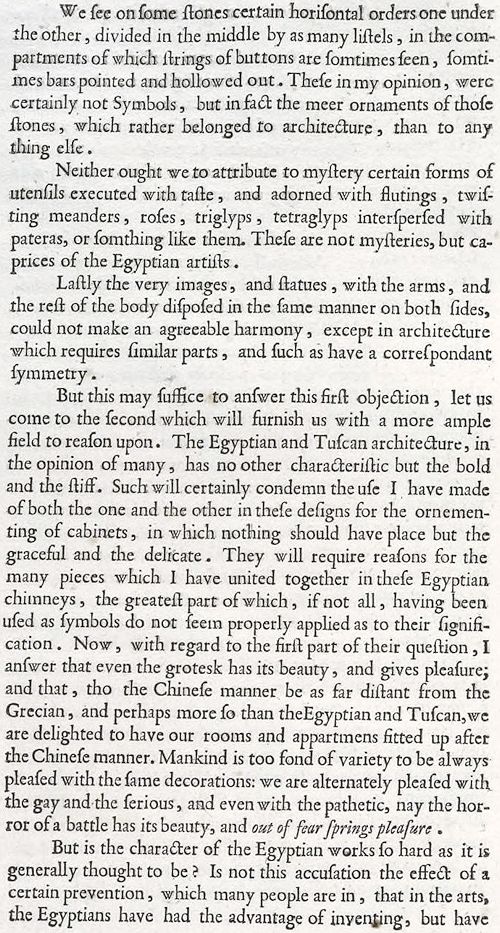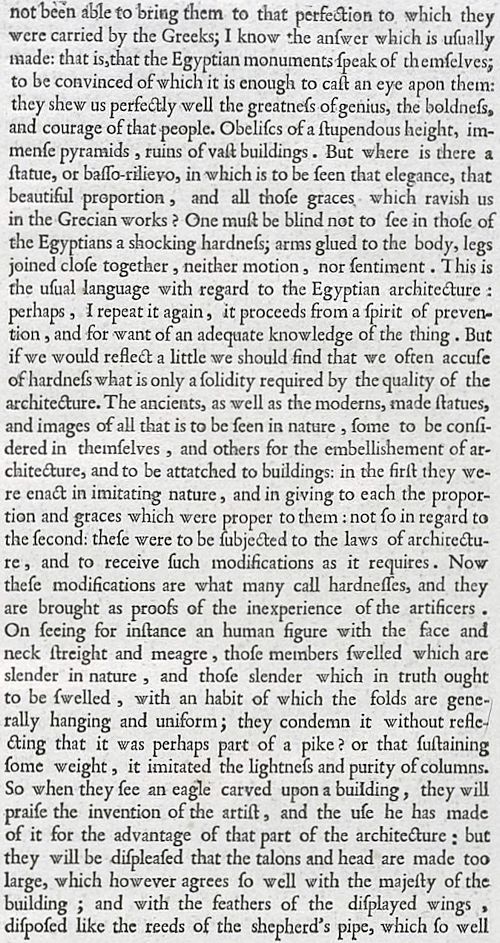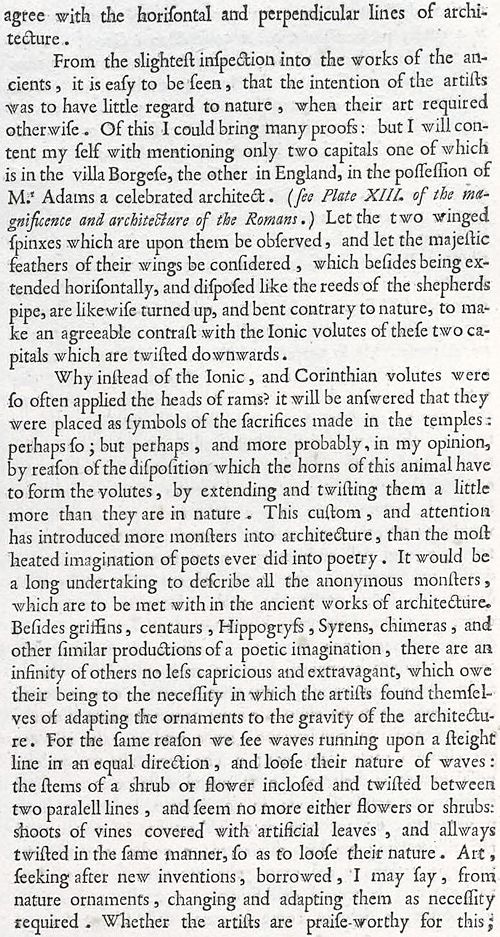
We see on some stones certain horizontal orders one under the other, divided in the middle by as many lifiels, in the compartments of which strings of buttons are somtimes seen, somtimes bars pointed and hollowed out. These in my opinion, were certainly not Symbols, but in fact the meer ornaments of those stones, which rather belonged to architecture, than to any thing else.
Neither ought we to attribute to mystery certain forms of utensils executed with taste, and adorned with flutings, twisting meanders, roses, triglyps, tetraglyps intersperfed with pateras, or somthing like them. These are not mysteries, but caprices of the Egyptian artists.
Lastly the very images, and statues, with the arms, and the rest of the body disposed in the same manner on both sides, could not make an agreeable harmony, except in architecture which requires similar parts, and such as have a correspondant symmetry.
But this may sussice to answer this first objection, let us come to the second which will furnish us with a more ample field to reason upon. The Egyptian and Tuscan architecture, in the opinion of many, has no other characteristic but the bold and the stiff. Such will certainly condemn the use I have made of both the one and the other in these designs for the ornamenting of cabinets, in which nothing should have place but the
graceful and the delicate. They will require reasons for the many pieces which I have united together in these Egyptian chimneys, the greatest part of which, if not all, having been used as symbols do not seem properly applied as to their signification. Now, with regard to the first part of their question, I answer that even the grotesque has its beauty, and gives pleasure; and that, tho the Chinese manner be as far distant from the Grecian, and perhaps more so than theEgyptian and Tuscan, we are delighted to have our rooms and apartments fitted up after the Chinese manner. Mankind is too fond of variety to be always pleafed with the same decorations: we are alternately pleased with the gay and the serious, and even with the pathetic, nay the horror of a battle has its beauty, and out of fear springs pleasure.
But is the character of the Egyptian works so hard as it is generally thought to be? Is not this accusation the effect of a certain prevention, which many people are in, that in the arts, the Egyptians have had the advantage of inventing, but have
| |

not been able to bring them to that perfection to which they were carried by the Greeks; I know the answer which is usually made: that is, that the Egyptian monuments speak of themselves; to be convinced of which it is enough to call an eye upon them: they show us perfecly well the greatness of genius, the boldness, and courage of that people. Obelisks of a stupendous height, immense pyramids, ruins of vast buildings. But where is there a statue, or basso-relievo, in which is to be seen that elegance, that beautiful proportion, and all those graces which ravish us
in the Grecian works? One must be blind not to see in those of the Egyptians a shocking hardness; arms glued to the body, legs joined close together, neither motion, nor sentiment. This is the usual language with regard to the Egyptian architetcure; perhaps, I repeat it again, it proceeds from a spirit of prevention, and for want of an adequate knowledge of the thing. But if we would reflect a little we should find that we often accuse of hardness what is only a solidity required by the quality of the architecture. The ancients, as well as the moderns, made statues,
and images of all that is to be seen in nature, some to be confidered in themselves, and others for the embellishement of architecture, and to be attached to buildings: in the first they were exact in imitating nature, and in giving to each the proportion and graces which were proper to them: not so in regard to the second: these were to be subjected to the laws of architecture, and so receive such modifications as it requires. Now these modifications are what many call hardnesses, and they are brought as proofs of the inexperience of the artificers. On seeing for instance a human figure with the face and neck straight and meager, those members swelled which are slender in nature, and those slender which in truth ought to be swelled, with a habit of which the folds are generally hanging and uniform; they condemn it without reflecting that it was perhaps part of a pike? Or that sustaining some weight, it imitated the lightness and purity of columns. So when they see an eagle carved upon a building, they will praise the invention of the artist, and the use he has made of it for the advantage of that part of the architecture; but
they will be displeased that the talons and head are made too large, which however agrees so well with the majesty of the building; and with the feathers of the displayed wings, disposed like the reeds of the shepherd's pipe, which so well
| |

agree with the horizontal and perpendicular lines of architecture.
From the slightest inspection into the works of the ancients, it is easy to be seen, that the intention of the artists was to have little regard to nature, when their art required otherwife. Of this I could bring many proofs: but I will content myself with mentioning only two capitals one of which is in the villa Borgese, the other in England, in the possession of M. Adams a celebrated architect. (see Plate XIII. of the magnificence and architecture of the Romans.) Let the two winged spinxes which are upon them be observed, and let the majestic feathers of their wings be confidered, which besides being extended horizontally, and disposed like the reeds of the shepherds pipe, are likewise turned up, and bent contrary to nature, to make an agreeable contrast with the Ionic volutes of thete two capitals which are twisted downwards.
Why instead of the Ionic, and Corinthian volutes were so often applied the heads of rams? It will be answered that they were placed as symbols of the sacrifices made in the temples: perhaps so; but perhaps, and more probably, in my opinion, by reason of the disposition which the horns of this animal have to form the volutes, by extending and twisting them a little more than they are in nature. This custom, and attention has introduced more monsters into architecture, than the most heated imagination of poets ever did into poetry. It would be a long undertaking to describe all the anonymous monsters, which are to be met with in the ancient works of architecture. Besides griffins, centaurs, Hippogryss, Syrens, chimeras, and other similar productions of a poetic imagination, there are an infinity of others noless capricious and extravagant, which owe their being to the necessity in which the artists found themselves of adapting the ornaments to the gravity of the architecture. For the same reason we see waves running upon a staight line in an equal direction, and loose their nature of waves: the stems of a shrub or flower inclosed and twisted between two paralell lines, and seem no more either flowers or shrubs: shoots of vines covered with artificial leaves, and allways
twisted in the same manner, so as fo loose their nature. Art, seeking after new inventions, borrowed, I may say, from nature ornaments, changing and adapting them as necessity required. Whether the artists are praise-worthy for this;
|